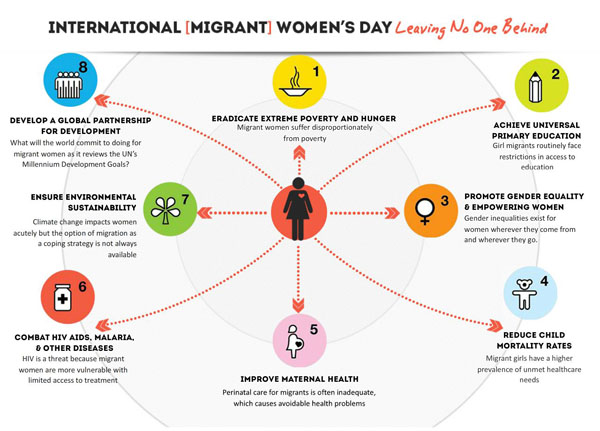-
Who we are
WHO WE AREThe International Organization for Migration (IOM) is part of the United Nations System as the leading inter-governmental organization promoting since 1951 humane and orderly migration for the benefit of all, with 175 member states and a presence in 171 countries.
-
Our Work
Our WorkAs the leading inter-governmental organization promoting since 1951 humane and orderly migration, IOM plays a key role to support the achievement of the 2030 Agenda through different areas of intervention that connect both humanitarian assistance and sustainable development.
What We Do
What We Do
Partnerships
Partnerships
- Where we work
-
Take Action
Take Action
Work with us
Work with us
Get involved
Get involved
- Data and Research
- 2030 Agenda
International Women’s Day - IOM Director General Swing: 'Integrate Migrant Women into Development Agenda'
Geneva - The International Organization for Migration calls today on the international community to ensure that migrant women are not left behind in the ongoing discussions on the post-2015 development agenda.
Observing International Women’s Day (8 March), IOM Director General, William Lacy Swing, emphasized the urgency to more systematically and thoroughly address the often unique situation of migrant women.
“We have now recognized that migrant women are half of the international migrant population. However, we too often pay lip service when it comes to acknowledging and responding to their specific circumstances and needs,” stated Ambassador Swing.
Today, approximately 111 million international migrants are women (from a total population of 230 million). They are present in virtually all types of migration flows, both high-skilled and low-skilled. They are no longer confined to family reunification and increasingly migrate on their own in pursuit of economic betterment. However, poverty and unemployment at home coupled with high demand for domestic and care services abroad push many to resort to irregular means of migration.
“I am most distressed to witness increasing numbers of women and children embarking on perilous journeys to reach better and safer shores. The tragic deaths that took place in Lampedusa and the Sahara desert at the end of last year highlighted that desperation migration is no longer a men’s preserve,” said Mr. Swing.
Migrant women experience migration in multiple ways, influenced by economic conditions. Typically, migration results in a mix of gains and losses. Generally migrant women seem to be faring worse than both migrant men and native women.
Statistics on migration and gender dynamics are limited and uneven across countries. But existing evidence – summarized by IOM’s infographic launched today – points towards poor result on all eight Millennium Development Goals (MDG). The data reveals that migration amplifies inequalities in both countries of origin and destination. Thus, women on the move are more vulnerable to exclusion, poverty, ill-health, exploitation and violence.
“We urgently need specific data to precisely understand the complexity of migrant women and girls’ situation. I strongly support the High-level Panel of Eminent Persons’ call for a “data revolution” and hope that this historical opportunity will be seized to start collecting data disaggregated at a minimum by sex, age, nationality and migration status. We should also make sure that the evidences cover South-North as well as South-South migration,” continued Mr. Swing.
Specific goals, targets and indicators for migration were not included in the MDG framework. IOM is appealing for an integration of migration in the post-2015 development agenda. “At least one in seven of the world’s population is a migrant, with half of them women. We will not fulfill our commitment to ‘leave no one behind’ if the needs of such a large and often vulnerable group are overlooked,” added Mr. Swing.
The discussions should focus both on addressing migrant women’s protection needs and recognizing their important contribution to development. Migrant women’s remittances are a significant source of social protection for their families left behind and often contribute to stimulating the local economies of their communities of origin.
“We should put all our weight in ensuring that a global partnership committed to maximizing the benefits of migration and minimizing the risks and human rights violations emerges from the Post-2015 agenda. And we need to make sure that this partnership works for women,” concluded Mr. Swing.
For more information, please contact
Sylvia Lopez-Ekra
Head, Gender Coordination Unit, IOM
Tel: +41.22.717.9478
Email: sekra@iom.int
